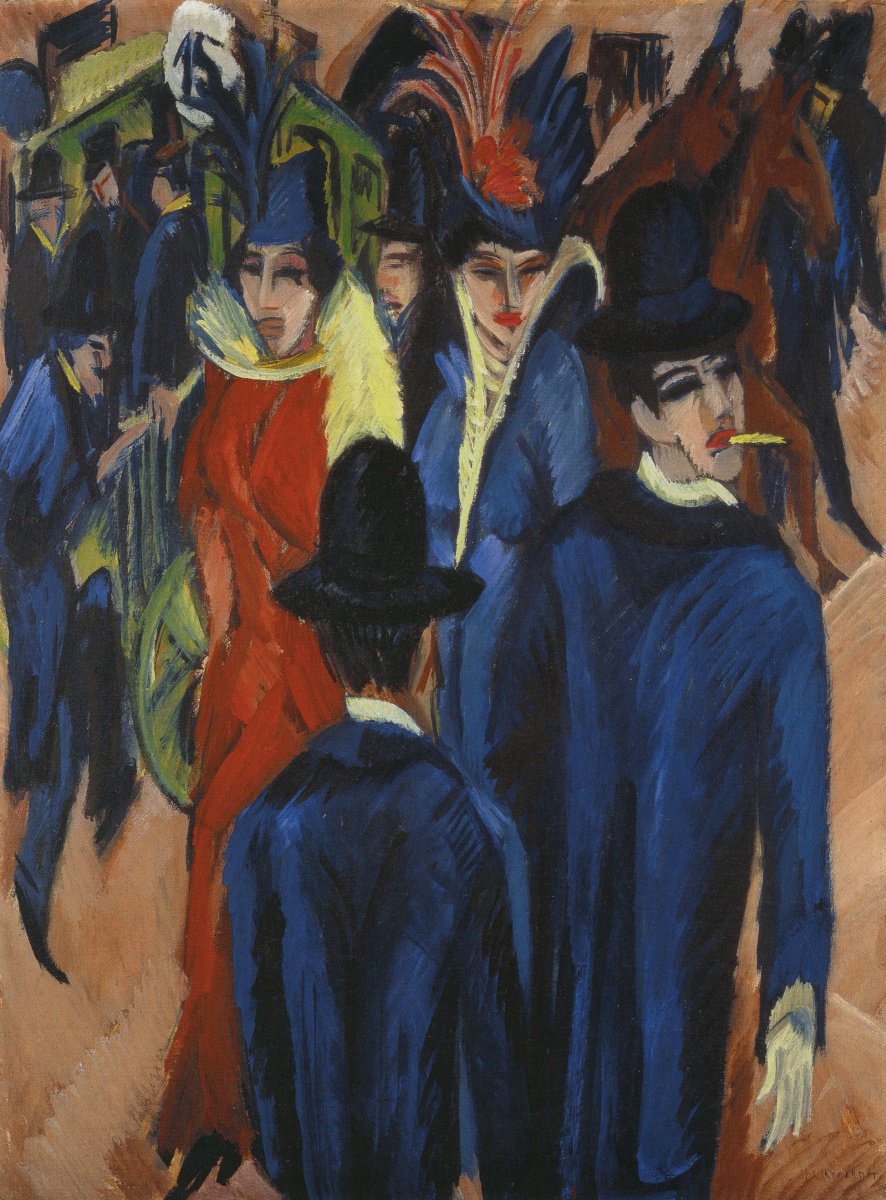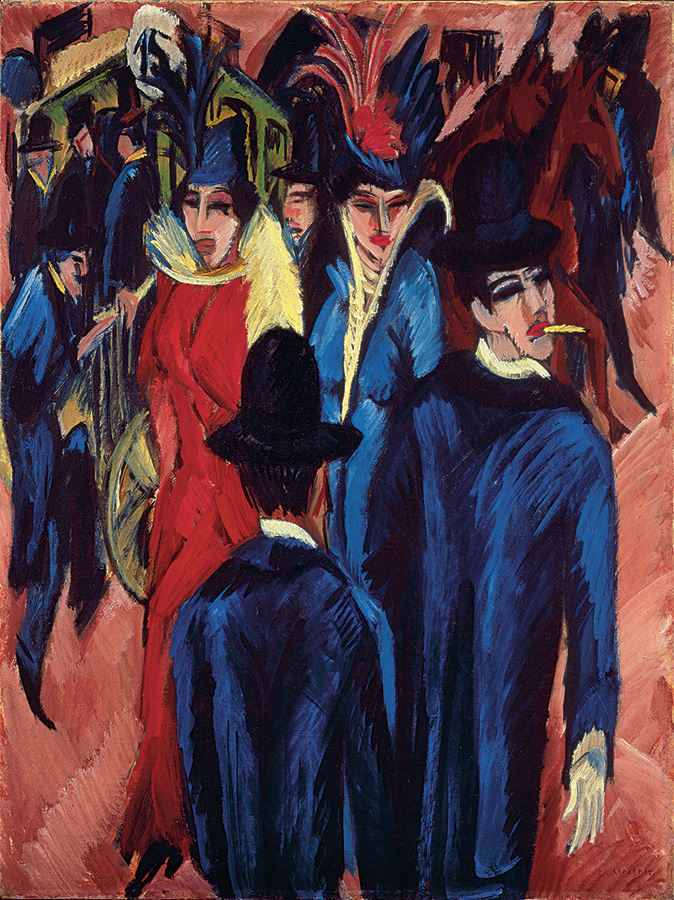log in
Enter site
Login to use Arthive functionality to the maximum
Berlin Street Scene
Ernst Ludwig Kirchner • Painting, 1914, 121×95 cm
Description of the artwork «Berlin Street Scene»
In 2006 year "Street Scene in Berlin" Ernst Kirchner - one of the most important paintings of German expressionism, according to auctioneers, was sold to a private collection. The tangled story that caused a wave of indignation among art historians, politicians, journalists and art lovers - rarely works of such value go into private hands from a public museum.
Brücke museum (a museum dedicated to the activities of the art association “The Bridge”) was forced to give the painting to Anita Halpins, who declared that she was the direct heir of the Jewish collector Alfred Hess, the first owner of the painting. Her grandfather was forced to sell the painting for a pittance during the persecution of the Jews by the National Socialist Party. In accordance with the Washington Declaration of 1998, the Berlin authorities agreed to remove the picture from the museum wall and hand it over to the family of the first owner. At Christie's auction the picture came in the same year and was sold at a record price for Kirchner - $ 38 million. The new owner of the Street Scene is Neue Gallery, a private New York gallery. Disputes around this decision have not subsided for many years: an ordinary commercial move by the heiress, a guilt complex by the German authorities, the unreliability of information about the first owner and the reasons that prompted him to sell (or maybe there was no prosecution? Maybe Alfred Hess just sold the picture and got good money for it?). In any case, the gallery owners and art historians are outraged, you can not just take and give such a significant museum exhibit, available to millions of people, in the possession of one person.
Ernst Ludwig Kirchner painted 11 paintings with Berlin’s nightly street scenes in the last prewar year, 1913. He moved from provincial and quiet Dresden to Berlin, the fastest growing and most illuminated city at the beginning of the twentieth century. Here the artistic manner of Kirchner, who still wrote nude in the wild during the summer raids on the Moritzburg lakes, is changing dramatically. Kirchner City is a metropolis in which it is lonely and uncomfortable, which excites and frightens in the same way with an abundance of opportunities and the aggressive light of nightclubs, restaurants, theaters, cabarets, cinemas. The heroines of this pictorial series are Berlin prostitutes, brightly dressed and defiantly visible.
Later, art historians will say that for Kirchner, selling love is a symbol: the commercial basis of all intra-city relations, flourished corruption, the battle between personal freedom and censorship in art, and at the same time corruption of art. The artist hardly formulated all these meanings as a program and an artistic task — Kirchner wrote not his own social libel, but his own feelings and state of mind, his own despair and loneliness. Despite the fact that there is a wordless agreement between male clients and urban prostitutes, despite the fact that the space of the picture is overloaded and densely filled with figures of people, all views are directed in different directions and all movements are fragmented. Here every man on his own.
Spending the evening on the central streets and squares, Kirchner makes many sketches - he now has several lines to indicate the movement, characters, facial expressions. He writes later that the attempt to convey the movement led him to abandon the one-point perspective; it is precisely several points of view that are capable of creating a sense of chaotic, scattered movement. Cropped figures in the foreground of the picture create the feeling of a random picture taken in the midst of a fast moving crowd. The elongated, angular faces are influenced simultaneously by two traditions equally equidistant from the surrounding reality: exotic African masks and ancient Gothic iconography.
Annoyingly bright, contrasting colors, restless, unnatural color of an unidentified background - all this together creates a new for the beginning of the twentieth century, but a very accurate sense of the approaching catastrophe, which gradually covers the inhabitants of pre-war Europe.
Author: Anna Sidelnikova
Brücke museum (a museum dedicated to the activities of the art association “The Bridge”) was forced to give the painting to Anita Halpins, who declared that she was the direct heir of the Jewish collector Alfred Hess, the first owner of the painting. Her grandfather was forced to sell the painting for a pittance during the persecution of the Jews by the National Socialist Party. In accordance with the Washington Declaration of 1998, the Berlin authorities agreed to remove the picture from the museum wall and hand it over to the family of the first owner. At Christie's auction the picture came in the same year and was sold at a record price for Kirchner - $ 38 million. The new owner of the Street Scene is Neue Gallery, a private New York gallery. Disputes around this decision have not subsided for many years: an ordinary commercial move by the heiress, a guilt complex by the German authorities, the unreliability of information about the first owner and the reasons that prompted him to sell (or maybe there was no prosecution? Maybe Alfred Hess just sold the picture and got good money for it?). In any case, the gallery owners and art historians are outraged, you can not just take and give such a significant museum exhibit, available to millions of people, in the possession of one person.
Ernst Ludwig Kirchner painted 11 paintings with Berlin’s nightly street scenes in the last prewar year, 1913. He moved from provincial and quiet Dresden to Berlin, the fastest growing and most illuminated city at the beginning of the twentieth century. Here the artistic manner of Kirchner, who still wrote nude in the wild during the summer raids on the Moritzburg lakes, is changing dramatically. Kirchner City is a metropolis in which it is lonely and uncomfortable, which excites and frightens in the same way with an abundance of opportunities and the aggressive light of nightclubs, restaurants, theaters, cabarets, cinemas. The heroines of this pictorial series are Berlin prostitutes, brightly dressed and defiantly visible.
Later, art historians will say that for Kirchner, selling love is a symbol: the commercial basis of all intra-city relations, flourished corruption, the battle between personal freedom and censorship in art, and at the same time corruption of art. The artist hardly formulated all these meanings as a program and an artistic task — Kirchner wrote not his own social libel, but his own feelings and state of mind, his own despair and loneliness. Despite the fact that there is a wordless agreement between male clients and urban prostitutes, despite the fact that the space of the picture is overloaded and densely filled with figures of people, all views are directed in different directions and all movements are fragmented. Here every man on his own.
Spending the evening on the central streets and squares, Kirchner makes many sketches - he now has several lines to indicate the movement, characters, facial expressions. He writes later that the attempt to convey the movement led him to abandon the one-point perspective; it is precisely several points of view that are capable of creating a sense of chaotic, scattered movement. Cropped figures in the foreground of the picture create the feeling of a random picture taken in the midst of a fast moving crowd. The elongated, angular faces are influenced simultaneously by two traditions equally equidistant from the surrounding reality: exotic African masks and ancient Gothic iconography.
Annoyingly bright, contrasting colors, restless, unnatural color of an unidentified background - all this together creates a new for the beginning of the twentieth century, but a very accurate sense of the approaching catastrophe, which gradually covers the inhabitants of pre-war Europe.
Author: Anna Sidelnikova



